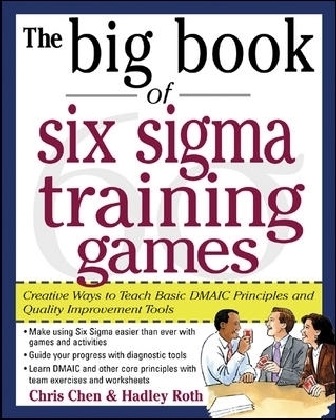Mehr lesen
Informationen zum Autor McGraw-Hill authors represent the leading experts in their fields and are dedicated to improving the lives, careers, and interests of readers worldwide McGraw-Hill authors represent the leading experts in their fields and are dedicated to improving the lives, careers, and interests of readers worldwide Klappentext An effective and engaging way employees can learn Six Sigma and put its concepts into play Part of the popular Big Book of Games series, which capitalizes on the proven effective method for workplace training, this first book of training games for Six Sigma ensures that employees will better retain Six Sigma's complex topics. This invaluable tool offers 50 experiential activities that teach the core improvement approach of Six Sigma, called DMAIC (Define, Measure, Analyze, Improve, Control), as well as many of the popular statistical improvement tools, including Pareto charts and Failure Mode Effects Analysis (FMEA). Zusammenfassung Provides an engaging way in which employees can learn Six Sigma and put its concepts into play. This book offers 50 experiential activities that teach the core improvement approach of Six Sigma! called DMAIC! as well as many of the popular statistical improvement tools! including Pareto charts and Failure Mode Effects Analysis. Inhaltsverzeichnis Introduction Chapter 1 Why Six Sigma? Process Improvement Basics What Is a Process? Process Simulations Exercise 1-1 Scrambled Letters (A Process Overview) What Is a Product? Value Propositions Exercise 1-2 Group Bid (Customer Value) Exercise 1-3 Vacation Planning (Exploring Value Propositions) What Is a Quality Product? Focusing on Customer Needs Exercise 1-4 Customer Landscapes at Affordable Prices (Identifying the Process) Why Is Each Product Slightly Different? Demonstrating Process Variation Exercise 1-5 Eyedropper (Examining Process Variation) Chapter 2 Who's on First? Roles and Organization Team Roles Exercise 2-1 Give-Get (Six Sigma Roles and Expectations) Exercise 2-2 Lights, Camera, Action (Dealing with Difficult Situations) Leadership Exercise 2-3 Team Poker (Leadership and Decision Making) Exercise 2-4 Historical Leaders (Urgency, Vision, and Message) Facilitation and Mentoring Exercise 2-5 Meeting Facilitation (Role Play) Exercise 2-6 10 Things I Do for Fun (Team Icebreaker) Chapter 3 What Is Our Quest? The Define Phase What Hurts? Formulating Problem and Goal Statements Exercise 3-1 Doctor, Doctor (Stating the Problem and Goal) Why Do We Need to "Get Better"? Stating the Business Case for Change Exercise 3-2 Precision Delivery Inc. (Stating the Business Case for Improvement) Where Will We Improve? Project Scope Exercise 3-3 Break It Down (Individual Process Map) Exercise 3-4 World Hunger (Creating Scope Statements) What Would Be Better? Translating Customer Needs Exercise 3-5 Dream Car (Finding CTQ Measures) Chapter 4 How Is the Current Process Performing? The Measure Phase What Should We Measure? Asking Questions and Testing Theories Exercise 4-1 Unscrambling the Federal Reserve (Collecting and Organizing Data) Exercise 4-2 Who's Here? (Collecting and Displaying Data) Do We Need to Measure Everything? Working with Samples Exercise 4-3 Precision Delivery Inc. (Data Collection and Sampling) Are We Speaking the Same Language? Operational Definitions Exercise 4-4 Super-Fine Peanuts (Applying Operational Definitions) Are the Measurements Reliable? Verifying Measurement Systems Exercise 4-5 Object of the Game (Assessing the Measurement System) How Good Is My Product? Measuring Process Sigma Exercise 4-6 Scrambled Letters (Measuring Process Sigma) Chapter 5 What Are the "Deep Dive" Causes of a Problem? The Analyze Phase What Might Cause the Problem? Developing Theories Ex...

